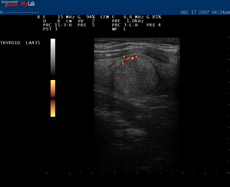|
|
 |
|
 |
 |
 |
Thyroid nodules are a common disorder, affecting as many as 50% of the population. Nodules can be caused by a simple overgrowth of "normal" thyroid tissue, fluid-filled cysts, inflammation (thyroiditis), or a tumor (either benign or cancerous). Most nodules were surgically removed until the 1980s. In retrospect, this approach led to many unnecessary operations, since fewer than 10% of the removed nodules proved to be cancer. Most removed nodules could have simply been observed or treated medically. The accuracy of fine needle aspiration biopsy has significantly reduced the number of unnecessary surgeries. |
 |
 |
Left Thyroid Nodule |
|
 |
Signs and Symptoms
Many patients with thyroid nodules have no symptoms whatsoever, and are found by chance to have a lump in the thyroid gland during a routine physical exam or an imaging study (CT or MRI) done for unrelated reasons. A minority of patients however, may become aware of a gradually enlarging lump in the front portion of the neck, experience a vague pressure sensation or discomfort when swallowing, or suffer from other symptoms such as hoarseness. Obviously, finding a lump in the neck should be brought to the attention of your physician, even in the absence of symptoms.
Detection and Diagnosis
It is not usually possible for a physician to determine whether a thyroid nodule is cancerous on the basis of a physical examination or blood tests. Endocrinologists rely heavily on specialized tests for help in deciding which nodules should be treated surgically. These tests include thyroid fine needle aspiration biopsy, thyroid ultrasound, molecular markers, and some in some cases, thyroid nuclear scanning. |
| Treatment |
Most patients who appear to have benign nodules require no specific treatment and can simply be followed expectantly. In select cases, levothyroxine will be prescribed with hopes of preventing nodule growth or reducing the size of the nodule, while radioiodine may be used to treat other types of nodules, particularly nodules which are overproducing thyroid hormone.
If cancer is suspected, surgical treatment will be recommended. The primary goal of therapy is to remove all thyroid nodules that are cancerous (and, if malignancy is confirmed, remove the remainder of the thyroid gland along with any abnormal lymph nodes). If surgery is not recommended, it is important to have regular follow-up of the nodule by a physician experienced in such an evaluation. |
|
| |
| |
|
|
|
 |
 |
MEDICAL DISCLAIMER: The information found on this website is for educational purposes only and is not providing medical or professional advice. It should not be used for diagnosing or treating a health problem or disease. It is not a substitute for professional medical care. If you have or suspect you might have any health problems, you should consult a physician. |
 |
 |
|
|
|